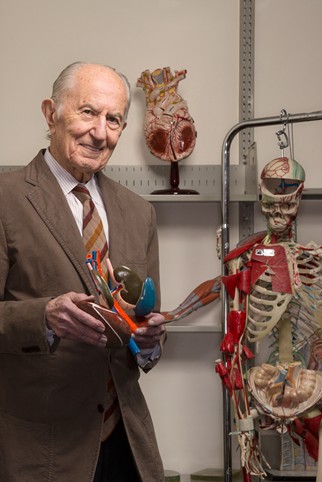After graduating from medical school at UT Southwestern Medical Center at the age of 21, and then returning after a stint at the National Institute of Health, Dr. Jean Wilson found himself a 24-year-old professor preparing the year’s first formal lecture to the junior students, on genetic diseases. He’d prepared for something like 50 hours. This was the early 1960s, and five minutes in, right down the middle of the aisle walked the great Don Seldin. Within a few minutes of that, Dr. Seldin, now sitting in the front row, blatantly pinched his nose, alerting to his displeasure. Then, he took off his glasses and laid his head on the table.
“I’ve always been proud of myself that I didn’t wet my pants,” joked Wilson, now a well-decorated professor emeritus of the school. After the lecture and after students cleared out, Seldin, who was toward the beginning of a 36-year run as chair of internal medicine, went back through the entire lecture the way he would’ve done it, the sort of dedication that gave Seldin so much room to criticize. Wilson recounted the story on the phone Thursday afternoon, a day after the “intellectual father” of UT Southwestern died at the age of 97.

Seldin, Wilson and other former mentees and friends said, had an uncanny ability to tip the lantern on every misstep in a way that propelled rather than deflated the one who’d been discovered. You were dead wrong, but you were still an OK person.
“He stood for something and he wasn’t willing to lower his standards just because someone was young or naive or wrong—or all those things,” Wilson says. “You admired him for never letting those standards fall.”
“He expected that you knew everything,” adds Dr. Robert Haley, a former student and current UTSW professor of internal medicine. “He didn’t accept if you didn’t know something.”
The master motivator came to Dallas in 1951, a 30-year-old who turned back to ask for directions a second time after first seeing the collection of broken down buildings that then made up the med school, as Michael Mooney wrote for D Magazine in 2013. He would soon become the only full-time faculty member, and early on thought about leaving. Instead, he proceeded to a six decade relationship with the school, serving 36 years as the chair of internal medicine.
Along the way, Seldin insisted that the academic side of the shop work in collaboration with the research side, a not-so-common vision back in 1951, says Haley. “He insisted that there be no walls,” he says.
His impact in building UT Southwestern into a top research university—including a handful of Nobel laureates—stands hand-in-hand with his broader impact on medicine. Harvard Medical School dean Dr. Eugene Braunwald once called him “one of the most impactful figures in the history of modern medicine.”
Of his local legacy, Haley says: “He’s one of the greatest men who ever lived in Dallas.”
It didn’t take long for Seldin to establish a reputation. Dr. Kern Wildenthal, who attended UT Southwestern starting in 1960 and would go on to serve as the school’s president from 1986 to 2008, says Seldin’s reputation was all the upperclassmen could talk about when he came for a visit.
“You arrived in anticipation,” Wildenthal says. Seldin didn’t disappoint. “He was a masterful teacher and a great clinician, and he really cared about the students and the faculty.”
Seldin had a knack for keeping talent around, as well. He’d send graduates away to places like the National Institute of Health to further their education while working offers to get them back as professors when the time was right.
“I think he knew I was not destined for a Nobel Prize,” says Wildenthal, who returned to UT Southwestern as an assistant professor in 1970 after receiving a Ph.D. from Cambridge in England. “But he was guiding me toward an administrative position at a very young age.”
Seldin was both knowledgeable and intellectually demanding outside of the medical field, as well. Wildenthal says he was a “renaissance man” who could “talk philosophy to philosophers,” recite quotes at a moment’s notice, and educate the table on topics like architecture and history. He was absorbed by the Dallas Cowboys, Haley says.
It took a while, but Haley eventually made a slow transition into a friendship with Seldin. For a decade, he ate lunch with him and other UTSW professors a few times a week. Haley made sure he’d read the New York Times. Seldin remained sharp as a tack and more than wiling to prove it, until very recently—Haley remembers being chatted up about something Seldin had read in the Economist about a month ago. Wilson sat down with him as recently as last week.
“Dallas is blessed to have an extremely high level of medical care,” says Haley. “And it’s absolutely traceable back to him.”




